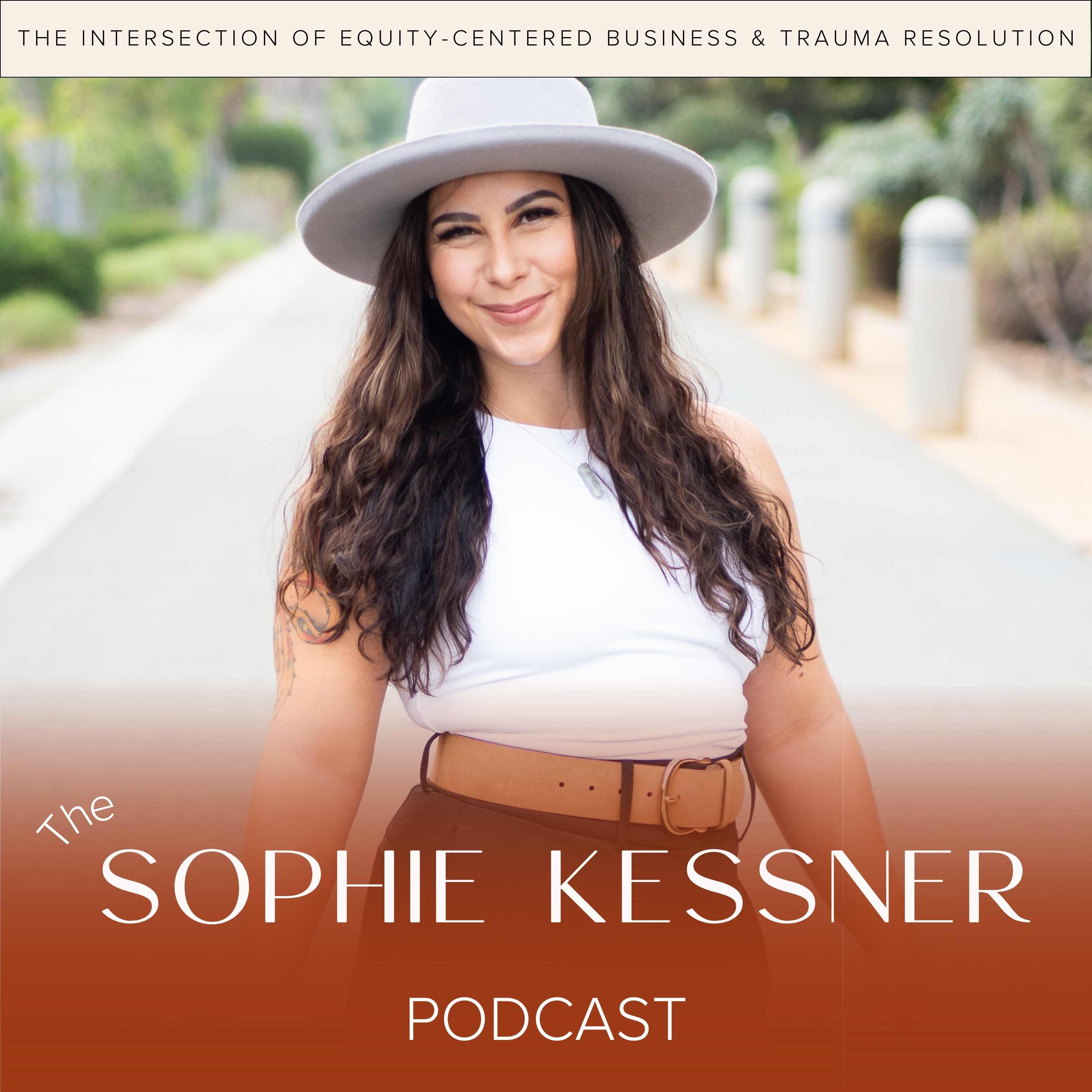Episode Transcript
Speaker 0 00:00:00 All right, y'all. Welcome back to a, another episode of the Sophie Kesner podcast. So in today's episode, I want to explore an interesting topic, and that is a conversation around the business model that we're utilizing and how we go about scaling, launching, and creating money online. So there's a lot of nuance in this conversation. There's a lot of opinion in this conversation, and I wanna acknowledge, first off that there's no right or wrong answer, and that I'm not saying that this is the right way or the wrong way, or in any way. Um, but what I want to do is just start to illuminate and provide insight on the intentionality and impact of different models and how, how they have the potential to either be really, really helpful or they have the potential to also become potentially problematic, so that when you as a business owner are making decisions about how you want to launch, about how you want to grow, about how you want to run your online business, you're doing them from a place that feels informed.
Speaker 0 00:01:03 You're doing them from a place that feels really clear in understanding the implications and the impact and the intentionality behind the way that you structure Saul and market online. So that being said, let's go ahead and dive in. The first business model that I would like to just unpack a little bit, uh, is the most common one and once kind of been around for as long as the industry has, uh, and then is the model of launches. So launching is a, is a typical thing that we'll have to do at any point in time if we are creating an offer that is for a larger group of period, uh, of people. Now, the way that a launch works is essentially you set a start date, and on that start date, you have a set group of, or a cohort, however you wanna, uh, define that, who all start a program at the same time.
Speaker 0 00:01:54 Now, what are the benefits to a launch? The benefits to a launch, uh, and to doing launch cycles is that you have clear determined seasons for marketing and for client delivery, and oftentimes they seldom overlap. What that means is you're either in marketing mode or you're in client delivery mode. And for some folks, this works really well. You spend six months outta the year in client delivery mode, and then you spend six months outta the year in marketing mode. But the challenge, or one of the cons with this type of model is that it creates a high dependency on needing to close a lot of sales and a lot of, uh, cash within a very short period of time. So if you have a cohort that's starting on a specific set date, then that creates a limitation for when people can actually choose to start and enroll and work with you.
Speaker 0 00:02:43 Now, I don't think that this is an inherently bad or wrong model, but what's important is to consider how this model works and how we're supporting ourselves to where we're not solely relying on a big launch or a big sale in order to run our business. So the, the challenge with the launch model, when we're talking about the online entrepreneurial world, especially for somebody who you, you have either just yourself in your business or you have maybe one or two team members like a va, uh, or, or a personal assistant, et cetera, is when the cart closes <laugh>, that is all of your cash for the year. That is all of your revenue for the year unless you do another launch. Now, the the beauty of that is if you have a really great launch, then fantastic. In two months, you've made your entire annual revenue and then you're done for the year.
Speaker 0 00:03:29 The pro con or the not so great thing in that is if you don't hit your launch goals, then you have to figure out what you're gonna do for the rest of the year to continue to generate the revenue you need to generate, for you to hit your annual revenue goals. And that can be really, really stressful for folks. So my personal opinion, um, on this, on this topic or on this matter, is that launches can be really great and they can work really well, uh, in tandem with other offers that are more evergreen. And what I mean when I say evergreen is it's speaking about offers that are enrolling and people can purchase at any other time of the year. And the reason why I personally believe that it's important to have both is so that you are not solely dependent on one time of the year generating the majority of your income, and you can have more financial stability and a financial rhythm or cadence that is supportive for the way that you want to run your life and your business.
Speaker 0 00:04:33 So if we look at this, the way that the launch model works, and essentially what we're breaking down here is you bring in let's say a hundred K in a two month period launching for a program that you're gonna be running for the rest of the year. What we have to think about from a business perspective, and when we really start to get into the way that we're managing our money, the way that we're managing our finances, the way that we're managing our business is that a hundred K needs to cover your expenses for the entire rest of the year. And so it needs to be divvied up over the length of the program. Um, and so that it's not actually just revenue that is covering all of the expenses for the the launch itself, but it's also the revenue that needs to cover the expenses for the business for the entire year and or the entire timeframe if it's a six month program, cover your expenses for the next six months, et cetera.
Speaker 0 00:05:23 Now, that is something that we don't oftentimes look at when we're thinking about businesses because looking at numbers oftentimes isn't very fun. Um, nor is it very sexy. It's a lot easier to say, oh, we had a hundred k launch than to say, yes, we brought in a hundred K in revenue, and that's a total annual revenue for the year for this offer, because that's the only offer that we're running. Uh, that means that the business has capped itself at a hundred K for the year unless it has other backend offers where its additionally generating revenue. Now, what that also means is if the company is doing a hundred k launch on the backend of that, we have
Speaker 1 00:05:56 To look, look at what are the total expenses or the expenditure of the company on a monthly basis, but then the annual, uh, annual total expenses or annual total cost of operating the business, right? Uh, and essentially what that's looking at is how much does it cost actually keep the business open? How much does it cost to deliver the service every single month? How much does it cost to pay yourself every single month to pay your taxes every single month, uh, to pay for the office that you rent or whatever other business supplies, um, or things that you write off at the end, end of the year as business costs or business expenses? Ideally, what you're doing here is you have a monthly budget in place, and you know what your baseline operational costs are. You know how much money that you're spending per month, uh, for yourself and then also for the company.
Speaker 1 00:06:43 And ideally, the way that you want to create this in, in my personal belief, again, there, there's not a, um, a hard fast rule here, but my personal belief is that you want to have what you call your owners pay calculated. So every month you pay yourself as the owner a set amount, and that owner's pay balance should be based off of what your bare minimum living expenses are. So what do you pay for rent? What do you pay for food, for gas, for groceries, um, for your car insurance, all those things. Calculate that. Essentially, that becomes your owner's pay. You know what your bare minimum needs to be. And then if you wanna pay yourself additional revenue or additional, uh, income each month and each year, then you would add that to your owner's pay. Now your owner's pay becomes part of your business'.
Speaker 1 00:07:25 Monthly expenses, right? So you've got what you pay yourself in your income as an employee or as the owner of the company, and then you have that showing up on the business side as a expense from for the business. So what you pay yourself is an expense for the business. Uh, and so that comes out of the business profit that's deducted from the bus just profit. So let's say you're paying yourself three K a month on average, three k over the course of 12 months. Um, I don't have my phone on me, but <laugh>, we can do the math in my head here. Uh, that would be roughly $36,000. Okay? So if we're paying ourselves a total of $36,000, and that's our, that's our cost for our owner pay, we deduct that from the business expense or the business total revenue that's generated, and we deduct the 36,000.
Speaker 1 00:08:18 That means at this point, the business is not generating a hundred k total in profit. It's actually generating closer to $64,000 in profit after expenses. Now, that's just for you and your owners pay. That's not including additional costs when it comes to team, when it comes to taxes, when it comes to any softwares that you're using when it comes to what you are paying yourself, uh, in an hourly wage for showing up for calls or doing all the other things or marketing expenses, et cetera. So you want to make sure that you're also taken in, into consideration other expenses that come into the business cost so that you can get a lot more clarity on what your profit actually is. Now here's something that's really interesting and a little discrepancy that I like to, um, just bring awareness into, is your owners pay your, what you pay yourself is your earned income.
Speaker 1 00:09:06 That's your profit for the, for the year and what you, what you've basically made, right? That would essentially be the same as like you working for a company and a company saying, okay, great, your salary is $36,000 a year. Um, for some people, that's fantastic, right? That's the money that you pay, but that's also the money before you pay taxes on it. So you have to also take into consideration what your, what your owner's pay is, is also gonna need to be, uh, tax, what is the word I wanna use here? Um, that's the money that you earned, and you're paying taxes on that as well, uh, depending on the way that you have your tax system set up. Now, I'm not a tax expert, nor do I claim to be, and none of this is tax advice. Um, I just have to, uh, put that caveat on there.
Speaker 1 00:09:44 This is just me service sharing my personal opinion and experience on these things, uh, and just providing a little bit of insight on what I make of all of the matters. Uh, but you should absolutely consult a text expert in your states of business and, uh, talk to somebody who is an expert in your business organization type. Um, so I'm not providing any, any technical information on any of those pieces. This is just a general overview. So that being said, um, what you, what you keep after you pay your taxes is the actual earnings of the business. And this is important to understand because I think a lot of the times we like to be financially naive, um, or, and are financially, um, oblivious <laugh> to what's actually happening in the company. And I know that this is a really, really, really big thing, uh, that I struggled with early on in my career because I didn't have the financial literacy growing up.
Speaker 1 00:10:38 I didn't have the education around financial literacy or how to, how to understand business expenditure, profit and loss taxes, uh, none of that. And none of that was ever taught to me. I wasn't educated on any of it. It wasn't something that I picked up or learned. Um, they just don't hate it in school. So I had to learn through trial and error and through a lot of, uh, painful, painful financial experiences when it came to tax season. Uh, so I share this now to try to provide a little bit of insight and information on the I importance of actually developing your financial literacy. And this is not just a conversation of like, have a big launch, make a bunch of money, and then just continue to make more money. There's a time and a place to yes, absolutely 100% make more money, but if we are not becoming financially literate and financially responsible and understanding how our money is being spent and where it is going, then it can quickly become a very negligent path that can lead to very risky financial decisions and put us in a very risky financial position.
Speaker 1 00:11:41 And what I'm talking about here is when our core focus is just launch, launch, launch, make more money, but at the same time, as we're launching and as we're launching and as we're launching, we're continuing to consistently increase our expenses. The thing that we don't recognize is our profit and our profit margins continue to shrink and shrink and shrink. And even though we might be making 10 k a month or a hundred k per year, because we are paying so much more for our expenses now to cover the cost of our living, because we've increased that, whether we're paying for mentors or paying for, uh, continued education, or we're paying for a, a higher cost of living, whether that's a nicer house or a nicer car, et cetera. These are all things that say, okay, great. That's, that's coming out of the, the total revenue of the business.
Speaker 1 00:12:21 And you're actually, your profit margin went from roughly 64%, right? If we're making $64,000 a year from the business after we pay ourselves $36,000 for owner's pay, uh, then we're, we're left with 64% profit margin. That's not bad. That's not bad. Um, but then we continue to increase our cost of living. And let's say now we're paying ourselves $50,000, uh, to cover all of the costs of the business, and then that brings the profit of the business to a 50% profit margin from a hundred K in revenue. We're paying 50%, uh, to ourselves and owners pay to cover our basic living expenses. That's an expense for the business. Uh, and the business is now only generating 50% revenue. Now, the interesting thing that, uh, that I find for a lot of folks, and that tends to be somewhat glamorized in the industry are, are just normalized in a lot of ways, is, uh, as you earn more, you just continue to increase your expenses, <laugh>.
Speaker 1 00:13:11 So you make a lot of money of a really big launch, great, reinvest that money immediately, invest all of it, invest more of it so that you can continue to make more. And it never actually allows for us to get to a space or a place to where we feel financially secure. We just feel in a lot of ways to, to put it lightly. Like we, we feel like we're just financially flowing and we're just going with the flow of the money, um, all the time. Our bank account is, is constantly going between like money coming in, money going out, money coming in, money coming out, and there's not consistency in in the earnings. So, uh, this episode has kind of turned into a conversation on financial literacy, <laugh>. We might have to do part two, uh, to, to go back to the original conversation of, of the, the business models.
Speaker 1 00:13:57 But what I, what I wanna end on in this note, and then we'll, we'll continue picking back up on, on the business model conversation in the next episode, is it's really, really important to understand that the, the money that your business makes is not the money that your, that you the owner keeps. And that when we're thinking about growing a business and where we wanna be, it's imperative to understand what our numbers actually are. And this is not necessarily a fun conversation always have, because sometimes it means that we have to come confront ourselves and confront where we have put ourselves into really risky situations where we have picked up on a lot of financial debt that now we have to pay off because we are investing in the business and investing in all of the things and investing in a certain lifestyle to try to portray a certain image of a success, et cetera.
Speaker 1 00:14:41 So what my invitation would be for those of you listening into this episode is number one, to actually pause and slow down and stop <laugh> for a second and really get clear on what your numbers actually are. Really get clear on like, what, what is my cost of living right now? How much, how much does it actually cost for me to live, to exist in the way in which I'm existing right now? Meaning my basic living expenses, my cost of rent, cost of food, cost of the car, cost of, uh, groceries, all of the things that you pay for on a month to month basis. And when you know that number, you know what your bare minimum salary for yourself or your owner's pay needs to be every single month and every single year. And that will tell you, okay, great. If if you want to live in, in a financially stable place, at the bare minimum, you need to be earning this much.
Speaker 1 00:15:30 Now, if your business is only bringing in enough to pay yourself, your business is not actually profitable. Your business is paying to exist <laugh>. So it's covering your basic expenses. Fantastic, right? Let's say your basic expenses are, your total living costs is between 36,000 to $50,000 a year. Fantastic. Your business is covering that amazing. That's the first stop. But the business is not actually profitable yet because it's just covering your cost of living. It's just covering your expenses. And if that's all owners pay, all of that money is going to paying yourself then right now, your business is not actually continuing to generate real revenue, and your profit margin is essentially zero or a very minimal percent because all of that is going towards paying yourself. So when we're starting to think about the profitability of a business, it's a whole, it's a whole juicy conversation, um, that we will have to get into in a future episode because we are running outta time today.
Speaker 1 00:16:22 So homework for y'all, if you are tuning in and you want to play along with me, is to sit down and actually work out a budget, work out a budget, and get clear on, okay, what are all of my living expenses? And then additionally, what is all of the debt that I have? What debt do I have that exists, uh, that I need to pay off? Whether that's a home loan, a car loan, uh, credit cards, uh, whether you're paying for, uh, business programs, et cetera. Write them all down, get clearer so that you know, okay, this is my debt, this is what I'm paying off in debt total, and then this is my bay bare minimum living cost. So once you have those numbers, feel free to tune in to the next episode where I'm gonna show you exactly what to do with those numbers and how to start to work with setting up your business to support you, and also figuring out the best business model that's going to work for the way in which you want to run your business, but also to do it in a way that's gonna be sustainable long term.
Speaker 1 00:17:12 Because if you are picking up one thing and taking away one thing from this episode, running a business just to cover our living expenses is not the business <laugh>, and it's not the situation that we wanna put ourselves in. It's incredibly risky and it never actually builds that sense of freedom that we want because we're just working to cover our expenses and we wanna set up the business to where we can pay ourselves equitably. We can pay ourselves an equitable salary, the business has profit, and we can start to put away a savings and actually work towards financial literacy so that we are setting ourselves up for real sustained su sustained success and growth in the business. Aria, that is it for today's episode, and I will see you in the next week, uh, next week's content. Well, we will go over the next steps of working with your business numbers.






